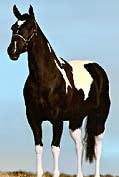Paint
America Paint Horse
Mon, 25th November, 2024 - 11:18 pm GMT
Sponsor Ads:

Alternative Name
America Paint HorseBasic Info
The Paint Horse's colorful coat pattern defines the breed, because it is perhaps the most obvious trait. However, Paint Horses must also possess a distinct stock-type conformation. Paints come in an endless variety of patterns. Their coat is always a combination of white with any of the basic colors common to horses: black, bay, brown, chestnut, dun, grulla, sorrel, palomino, gray and roan. Regardless of color, no two horses are exactly alike in coat pattern. For registration and breeding purposes, American Paint Horses are categorized by three distinctive types of coat pattern. The tobiano (pronounced: tow be yah' no) pattern is distinguished by head markings like those of a solid-colored horse; their heads may be completely solid, or have a blaze, strip, star or snip. Generally, all four of the tobiano's legs are white, at least below the hocks and knees. Their spots are regular and distinctly oval or round, extending down the neck and chest, giving the appearance of a shield. Usually a tobiano will have the dark color on one or both flanks - although a tobiano may be either predominantly dark or white. The tail is often two colors. The overo (pronounced: oh vair' oh) pattern may also be either predominantly dark or white. But typically, the white on an overo will not cross the back of the horse between its withers and its tail. Generally, one or all four legs will be dark. Also notable is that overos have bold white head markings, such as a bald face. Overos generally have irregular, scattered markings. The horse's tail is usually one color. Not all coat patterns fit neatly into the tobiano or overo categories. For this reason, a number of years ago the APHA expanded its classifications to include "tovero" (pronounced: tow vair' oh) to describe horses that have characteristics of both the tobiano and overo patterns. What is especially fascinating about Paint Horse breeding is that the genetics of coat color inheritance is still not readily understood. Like when diving for treasure not every oyster produces a pearl, not every breeding of two Paint Horses results in a colored foal. This makes each Painted foal that much more valuable
Health
N/AHabitat
N/ABehavior
Built for versatility, the American Paint Horse is generally short-coupled, strong-boned and well balanced. Yet Paints display a remarkable degree of refinement and beauty, especially about the head and neckOrigin
AmericaHistory
Descended from horses introduced by the Spanish conquistadors, Paints became part of the herds of wild horses that roamed the Western deserts and plains. Once domesticated, because of their working ability and heart, the Paint was cherished by cowboys for cattle work. Native Americans revered the Paint, which they believed to possess magical powers. While over the years the conformation and athletic ability of those rugged mounts of the Old West have been improved by breeders, the unusual coat patterns and coloring remain the same. The stock-type conformation, intelligence, and willing attitude make the American Paint Horse an excellent horse for pleasure riding, ranch work, rodeo, trail riding, racing, showing, or simply as a friendly mount for the kids.Common Foods
grassSponsor Ads:
Love is the most subtle form of self-interest. --Holbrook Jackson
Paint
Coded by: BGID® | ALL RIGHTS RESERVED Copyright © 2000-2024
Disclaimer | Privacy | Report Errors / Contact | Credits


 Homosexual behavior stems from the mind or genetics?
Homosexual behavior stems from the mind or genetics?  The Best Text Adventure You Will Ever Play! The official site:
The Best Text Adventure You Will Ever Play! The official site:  Why haven't we as a collective earth met with aliens yet?
Why haven't we as a collective earth met with aliens yet?  World EcoSystem - Biodiversity Changes - Who is on board and who isn
World EcoSystem - Biodiversity Changes - Who is on board and who isn  Mouthwash - Mouthrinse - Mouth Sores - Healing Infections - Gingivitis
Mouthwash - Mouthrinse - Mouth Sores - Healing Infections - Gingivitis  Treatment for Depression
Treatment for Depression  Ultra radical and violent Islamist group that even rivals Al Qaeda
Ultra radical and violent Islamist group that even rivals Al Qaeda  An idea to have teachers who want to carry guns to school undergo some level of police training will be left up to local school districts and police departments.
An idea to have teachers who want to carry guns to school undergo some level of police training will be left up to local school districts and police departments.